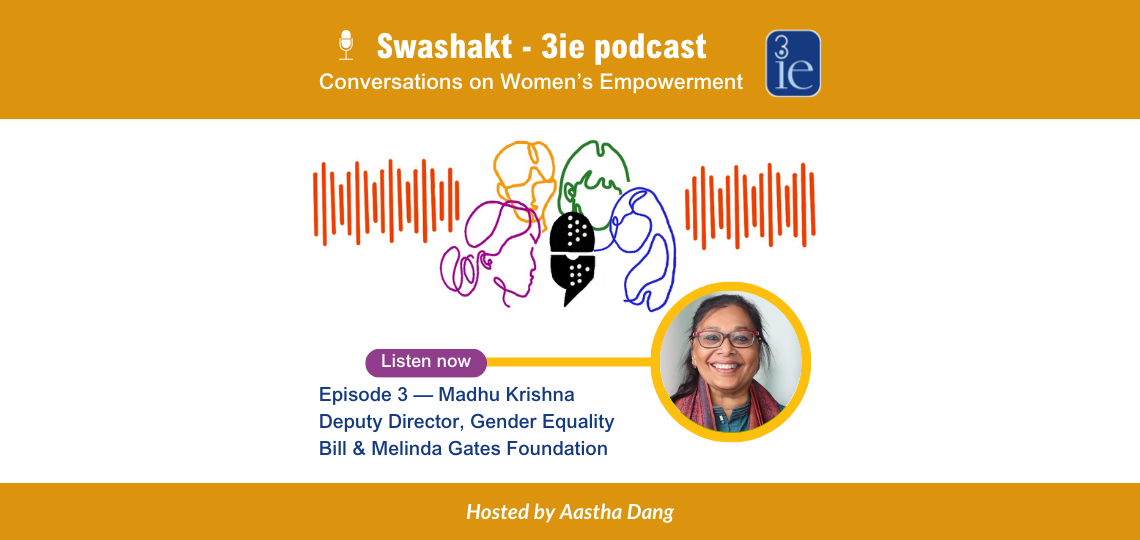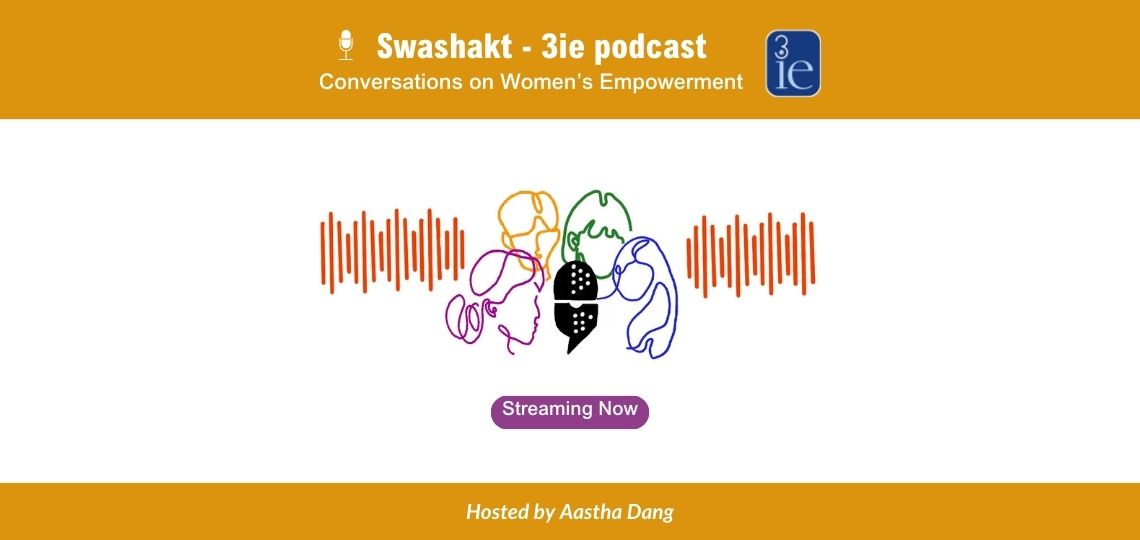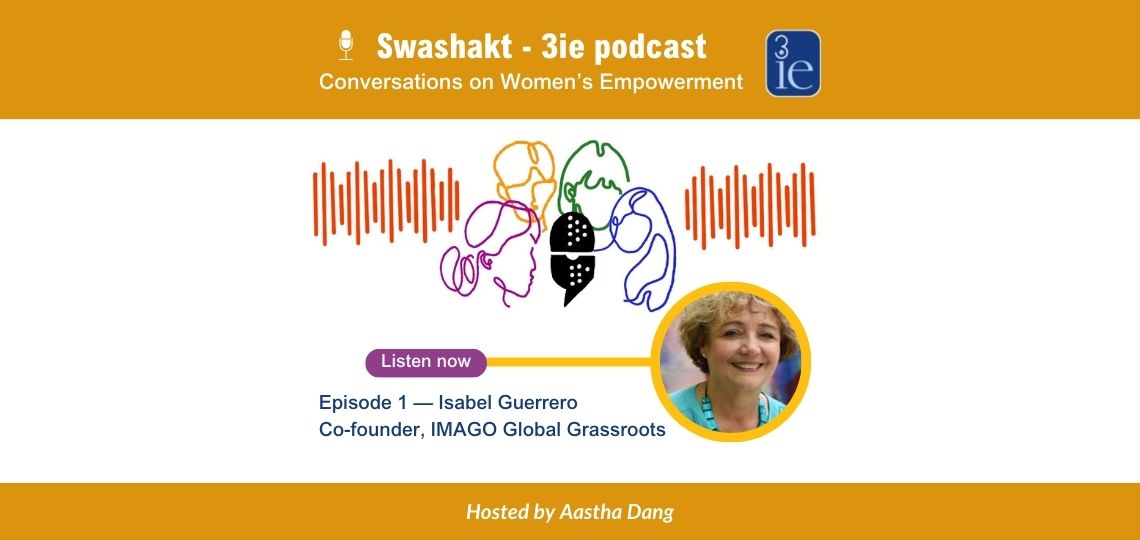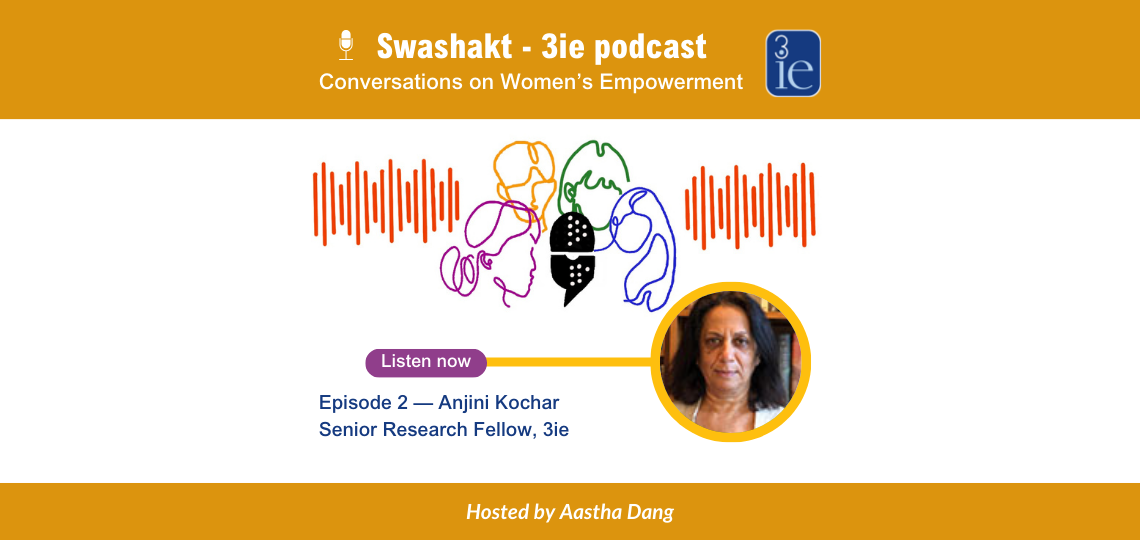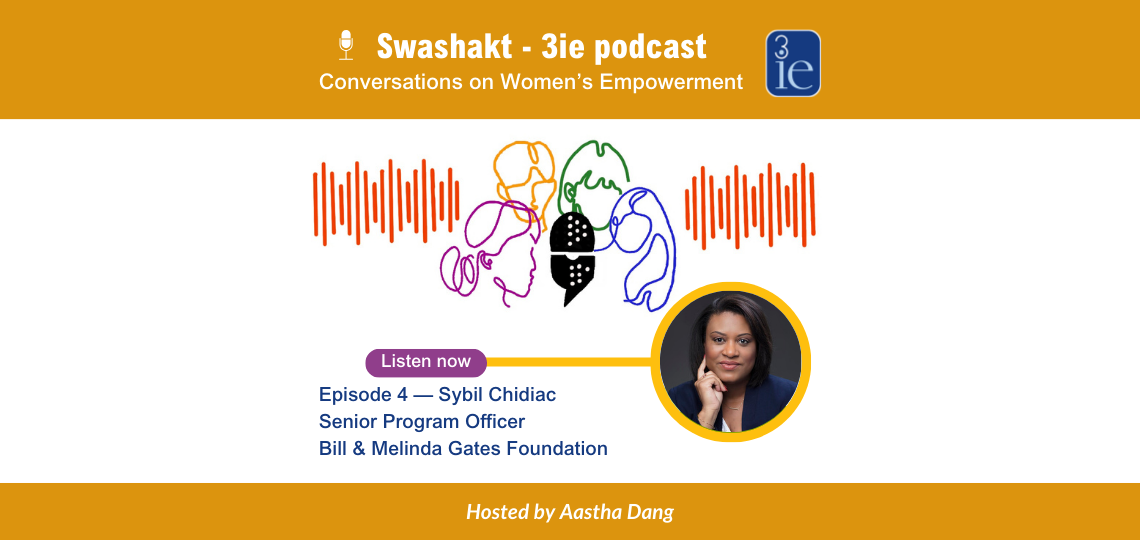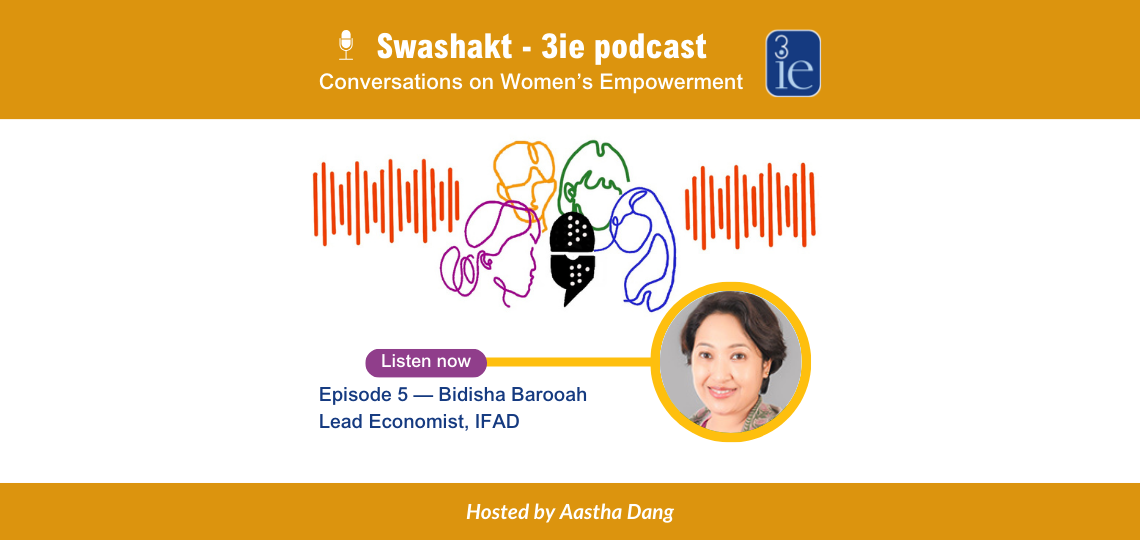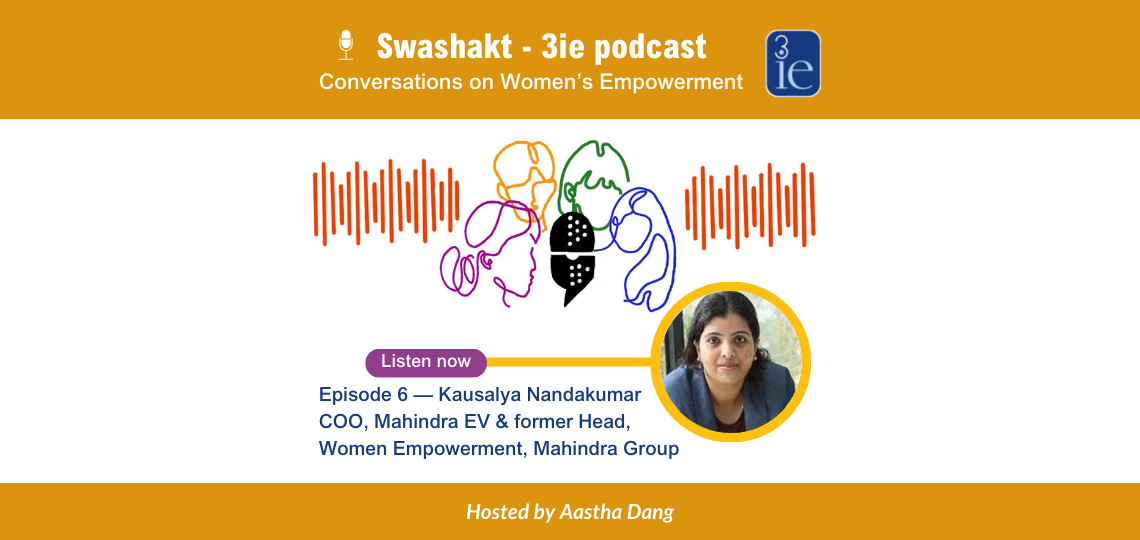Realizing women’s full potential – with Madhu Krishna
About the episode
In the third episode of the Swashakt podcast, 3ie evaluation specialist Aastha Dang speaks to Madhu Krishna who is Deputy Director, Gender Equality at the Bill & Melinda Gates Foundation’s India office. She leads the Foundation’s investments in India to advance gender equality. Her areas of focus include technical solutions, public policy, strategic communications, community engagement, and large-scale implementation of proven interventions. Krishna explains why we need to focus on attracting, retaining and advancing women in the workforce and help build structures that allow women to realise their full potential.
This podcast series has been produced by the International Initiative for Impact Evaluation (3ie) and is inspired by our Swashakt evidence program and our Rural India Livelihoods Project. The views expressed are those of the speakers and do not necessarily reflect positions or policies of 3ie.
Host: Aastha Dang
Production lead: Kirthi V Rao, Tanvi
Production support: Annie Vincent, Durgadas Menon, Shailendra
Disclaimer: The podcast has been edited for clarity.
[Intro]
Aastha: The world is not on track to achieving Sustainable Development Goal number 5 on gender equality and women's empowerment. Where have we reached and how far do we need to go? While data can throw light on this question, there is no substitute for the wisdom of practitioners. Join us for this podcast series as we try to understand empowerment better and explore the pathways towards economic empowerment, in particular self-empowerment for women who are part of collectives in low- and middle-income countries. We are talking to a series of women whose training and experience can act like beacons on this journey. I'm Aastha Dang, evaluation specialist at 3ie. I have with me today Madhu Krishna, who is Deputy Director at the Bill and Melinda Gates Foundation and leads the foundation's investments in India to advance gender equality.
[Standing up and stepping up for the community]
Aastha: Hi, Madhu. Thank you so much for joining. And I'll jump straight to the questions. So my first question to you is, whom do you see as an empowered woman?
Madhu: For me, it is very simple: an empowered women is someone who is able to exercise her own agency, voice and determination to aspire to her own goals and ambitions for her life. That's an empowered woman for me. And then we also know that this requires a lot of courage and resilience in the environments in which women operate. Especially when we talk about the kind of women we meet in our line of work, which are largely from low-income households, both urban and rural. So a majority of these women are riddled with a kind of internal conditioning from the time they're born. We all can relate to that, yeah? The kind of gender norms that are prevalent in our societies, almost a position of subservience. You are always told you are almost like a second-class citizen right from the get-go. There are barriers as well that are then imposed on them as they go up, both physical and social barriers that are: starting from gender-based violence, intimate partner violence, societal violence.
Then a lack of safety therefore in mobility. So the ability to actually make a decision that ‘oh I want to work 15 miles away from where I stay’. I may not have the transportation, I may not have the resources and I may not have the safety, to come back home safe at night. And then added to that, from a very young age, women and girls are also the main caretakers of a large number of household duties, childcare facilities, making sure that food is on the table and making sure that water is available. So all of those extra activities, domestic and social responsibilities, all fall on women again. Reducing her time for being productive in the way that is counted.
So these everyday challenges and these barriers are what the women that we work with face. To an exaggerated extent that even sometimes we don't have an idea. And yet, they stand up, they step up for their communities, for their families. And when they see actual economic distress they go out and do what is socially accepted as productive work to the extent that they are able to. Whether it is, you know, taking a loan to set up a sewing machine, hand embroidering, are doing hard labour, trying to get NREGA work days working on the field, even if it is not counted as labour right. So it's really, those women who are actually truly empowered as well, because they stand up to those barriers and still want to make a better life for themselves and their families. So this I think is who I see as a truly empowered woman.
[Creating a sustainable economic environment]
Aastha: Madhu, this answer really touched me, because what you said about courage, I think this is the most important point and thank you for voicing it so well. My second question is you know you can working in the field of women's economic empowerment for quite a long time. So what is it that excites you about promoting women's economic empowerment?
Madhu: I think this is it. This is the kind of courage and resilience that I see every day. These are the empowered women who inspire me every day that there is a way to make life much better. Because if they could take these barriers and challenges and make a better life for themselves, imagine what they could do if we could reduce some of those barriers and create a more sustainable economic environment for them and create more economic opportunities for these women who are willing to step up and, you know, climb these mountains. So maybe we reduce those mountains and create a more equitable platform for them to actually go (forward). I think all society, all communities all of the world would be a much better place that we could do that. So that's what drives me every single day.
It's quite inspiring how I see, if I go into the field. I just recently went to UP and saw a woman who was a banking correspondent. She had a digital device and within second she was telling us how many financial transactions she done in a day, how many customers she'd serviced, so how much money was transferred just in gross terms. But the empowerment she felt because she was the finance go-to person in her community. Both men and women came to her because she was the one-stop finance person helping them navigate their bank accounts. And you should have just seen the way she was dealing with them right and dealing with us - so much confidence.
And she was breaking gender stereotypes, right? Men and women are coming to her for their financial information, whereas women were always told you don't understand money. Actually, they understand money better than anyone because who manages a tight budget at home right and still makes sure that two meals or three meals are put on the table? So she manages, you just have to raise that awareness and give her some technical skills and boom, you can see swift progress.So I just feel all of this is so inspiring. To see where women are and where we can take them, regardless of the social and economic structures.
[Leveraging collectives is key]
Aastha: I think what you said is super important. In a way, you also answered the next question. But I still want to ask you again: how can we support women's group and individual enterprises to empower women and strengthen their voice and agency?
Madhu: So I think collectives are super important. All of us work as a collective, right. We are a collection of development professionals. We learn from each other. We just had a conversation of how I can help, or you can help me build a network right? If I want to learn more about data and evidence, I will come to my partners at 3ie and say, hey, explain to me what is this sampling technology? Why would you choose this group versus another? If you needed to make some connections that we as a Foundation have, right, then I will connect you to my connections, my networks, people I know in my field. So we all work as a group. We are social animals. Women often don't even leverage their own group collectivization, right?
So I am so, so proud of India. I think we are such an exemplar from way back, maybe 30 years when NRLM and maybe its predecessors were conceived. At both the vision that you know women need these formal collectives in order to find a safe space for them to talk about challenges, whether they are family or community, or economic challenges, find a way to help each other right? Because it started with all of us putting in a small amount of money and then sharing those resources across the group, a pure lending kind of thing.
That's how these self-help groups came about and from that evolution to where they are now: in the cluster level federations which now big-time foreign researchers, everyone is saying will be the future right? India is also the place where you have cooperatives. And many of them didn't work, but those that have worked are exemplars. The Harvard case studies Amul is a cooperative, I have actually met the board which are a set of farmers who have professionals helping them, but Amul is owned by those farmers' collective right?
So the power is so immense. My own father was an economist who believed deeply in grassroot organizations and collectives, because until we collect and have one voice, whether we are in our own organization or in big societal organizations, those community groups are the ones that are going to drive change whether it is a political party or there is an economic collective, or it's a savings group, or it's a women's group. Right. So the power of collectives cannot be denied. There is historical evidence.
And there is more solid evidence on how they actually help women grow their own voice and agency. Really hard to fight a battle all on my own. And none of us actually do. We either have a social circle or a friend circle or we have family support. And the fact that we have now instituted this and that women actually fight, as I said, they sometimes face huge domestic violence to come to those SHG meetings, but they still come. There is value in it, right? Not just an economic value. They see a social value.
Then similarly we have seen the various committees. For instance, social action committees that have been set up within the SHGs and the cluster-level federation. They actually help women deal with their own personal issues as well. So I think it's not even a question of why we would work with empowerment collectives. Again, huge kudos to the Indian government for continuing to put in resources and the huge amount of mobilization. Look, it takes a lot of time to get people to come together. The fact that today we have 84 million women connected into SHGs and growing, every month the number grows. That kind of social mobilization is just unprecedented in any country in the world.
We believe that we also have to look at other channels that are evolving. I spoke about digital channels and spoke about platform economies, also spoke about informal work, especially in urban areas because there is also a real movement of urbanization. Therefore a mission like National Urban Livelihood Mission, which will not be a copy-paste of NRLM. It has to be different because urban spaces are very different. But if we can get some sort of ward committees to come together and work, I think we will see a transformation of our cities in the next 20 years. NRLM and the CLFs have to continue to grow, NULM has to grow. And how do we partner those with some of the new channels that are coming. So if its like a digital economy or platform, can NULM bring its women together?Because see the biggest cost is onboarding women and is discovery: where are they, right? So the easiest is always to play in rural areas because you can go to a village and say where are all the poor houses and somebody will be able to take you. In urban spaces, that is different. But even in rural most people have shied away from you know, private sector players have shied away but now are seeing the value of okay, there is already a platform, I can just go to the SHGs, the 2-3 SHGs in a village or in a block in a district or a village organization and there are all the women I need. Because the focus is all on lower income, scheduled caste or scheduled tribe women that are most disadvantaged. So there is a platform. So if we can make that partnership work better, I think it is a huge win. So government resources in social mobilization and creating the platforms, creating the community institutions. And private sector players then can work with those platforms to create better job opportunities and economic opportunities. That to me is the next big step instead of working in silos.
[Attracting, retaining and advancing women]
We have come up with a 3-pronged effort, our theory of change for women's economic empowerment. One is to attract women. So all those women who have not yet entered the workforce, how can we attract them? And that means building the right kind of platforms, building the right kind of flexible working hours, building the right kind of economic opportunities to attract more women into the workforce. Then we see during her life cycle she could leave because of certain care responsibilities, maybe the husband has got transferred and she has to take the hit on her economic opportunity. So how do we retain women in the workforce and then how do we advance them. So they go from being very subsistence, to getting to much higher levels. So wherever be their base. If there is an NREGA worker can we help her create productive assets so that next time she doesn't have to be an NREGA worker, but is running a micro-enterprise of her own or is part of one of those enterprises. Wherever she is, can we advance her economic gains? Even if she is at a corporate level. There is a huge gender pay gap. So how do we address that? Is there a policy fixed? Are companies to be told through data that look at the gender pay gap you have: engineer to engineer, a woman gets paid less. Why? So for us it is about attracting, retaining and advancing women in their workplace.
[Ability to generate and control income – five levers that matter]
Aastha: Madhu, what are some common beliefs about women's empowerment that you would question?
Madhu: So, it is very important to be clear about our own understanding of what empowerment means, right? It is not just about giving someone power, it's about women understanding their they have their own power, right? So when we say empowerment, it still feels like someone is giving something, but actually it's about helping women realize their own power, their own voice, their own individuality, their own agency and building the structures that allow them to use these to their full potential. We have also evolved our own journey, especially around the WEE portfolio: not just to focus on women's empowerment as a broad objective and something that's aspirational, but to clearly have a metric around what we want to see. So we want to focus on women's ability to generate and control income. It's not just she should be economically empowered. But a key enabler of empowerment is that she should be able to generate and control her income. So she has control over her income. And anchored on this north star, we have established clear pathways and identified five levers. We looked through a bunch of levers that we worked out and we have come to five levers. One is capital, right? All of us need some capital whether it's credit, whether an asset. We can't really have an economic opportunity if we don't have capitals. So that's the key lever.The second is digital, because that's evolving as a huge lever, right, for me. Even if I'm in a rural area, how do I expand my enterprise if I don't have a value chain and a marketplace? And digital marketplaces are a great place to go. So I, sitting in a village in Begusarai (in Bihar) can actually be addressing an international market, which men have now started accessing. As long as I have a good agriculture enterprise and a collective, I can actually play on that. So how do we look at digital for women's enterprises. The 3rd lever is around markets. So, more broadly, making sure that she has access and whatever are the market failures that do not allow her to participate equally. How do we leverage pathways to make those markets more robust, whether they are digital or analog. How does she get more access to markets?
Care is a big burden, right? So how do we address the whole issue of care? For us, care can become a big win-win because there's a great economic opportunity as long as companies and governments are willing to invest and see that as a big lever. And that's what we are trying to push currently at the policy level to make everyone understand what is this childcare burden, which is why women have to drop off, right? And if we didn't have a set of women who are willing to take that hit, you wouldn't be able to have the next generation right? How do you get children taken care of? It's not just in school, pre-school children, huge safety issues for children, nutrition issues, etcetera. So how do we look at care and care as an economic opportunity as well? So, one, women who want to be in the workforce and need a safe place to keep their child while they are at the workplace and two, women to run those (childcare) enterprises. So then it is a care economy that's built up. That's the 4th big lever for us because that's the biggest barrier currently, right, that we see. And then the fifth is data to support all of this, right? And so those 5 and data means similar to what we had said earlier, how do you make sure that people understand what the gender disparities are? Even in 2022, we are talking about huge gender pay gaps for the same roles. So unless we have the data, people won't move. They say when you have data, people move. So five levers for us are very important: capital, digital, market, care and data. So these are all the five levers that will be working on.[Crosscutting initiatives – a crucial need]
Madhu: What happens is that these are some common beliefs that I created an opportunity and women don't come. But without the realization that women's economic empowerment needs all of these and people work on maybe one or two. Some may work on market, some may work on digital, some may work on capital. But they don't understand that you actually have to work on multiple (levers). And I think there is one that is crosscutting. Then we have some cross-cutting initiatives which is upskilling women so that they continuously advance in their roles. The other one is around barriers, reducing social norms and barriers. And that needs the whole of the Foundation, the whole of the country to come around right? So those are longer plays, they are cross-cutting, but it does require people in decision-making to make changes in the whole way that the world is set up. Cities are not set up to be gender friendly. Huge dark spots. Transportation. Now Delhi has got reserved trains or reserved cubicles in the trains. They have buses but it's not universal. So how do you make sure this is universal? How do you have lighting where women go? How do you ensure that PoSH (Prevention of sexual harassment at the workplace) guidelines are followed everywhere, so that women feel that they are in a safe space when we talk about the urban spaces. In the rural too, the roads are very unsafe, are not lit, and transportation is a difficulty. Even if you give them scooters, will they be picked up from there, will the scooters be stolen? How do you provide for women so that their opportunities are there, or do you give them flexible working hours? So that they can work or find jobs closer to where they live. Because if they don't actually want to travel for whatever reason. So how do you make the world much more gender friendly? Currently, it is a very male-dominated perspective in how the world functions. It is not set up for women and they have to navigate their way courageously and with resilience. As do you I am sure. You also have to figure out what's the safe time for me to go? And if I go on the DTC (bus) will I get ragged? What should I do? Should I take an auto? How do I look at the auto? A man doesn't make all these 50,000 decisions when they step out to go. So it doesn't matter where you are, the world is not set up for us.
But courageously, we still manage to try and break those down, right and try and influence the way the world is set up, the way our both places are set up. Easier maybe for us, not so easy everywhere.
[Public and private sector collaboration and learning]
Aastha: Madhu, my next question is what, according to you, are the key obstacles in promoting the link between collectives and women's empowerment? Is it the scope, the range and duration of the private sector investments or of the public sector programs? What do you think?
Madhu: Government processes by the private sector are seen to be too onerous and too complicated. And the government does put in a whole bunch of barriers before they start engaging with the private sector. I think slowly both sides are realizing, the private sector is realizing, if I have to work at scale and the kind of resources I need, my impact will be very small until I start working with large-scale government programs which have bigger resources to put forth for development programs. The government programs have come to understand that innovation, understanding, private sector drive and enthusiasm and energy are required to make their programs much more effective. So slowly, and I'm not saying it's a done deal, but slowly this realization is happening, trying to bring them closer. So I think that is important. The other thing that I would say that NRLM, if we take that example, when it was set up, it was really focused on driving social mobilization. It focused a lot of its energies on social mobilization, not with a very clear vision on livelihoods per se. Savings, yes, as the groups came together, and institution building over time. But very little on what is really the social norms and barriers that these collectivized women face, both as a collective but as individual women. So the gender curriculum, which came out of your study itself, as a big missing piece, I think it has now been very successfully adopted by NRLM and they are taking great measures, proactive measures to actually scale that. So I think that's a shift that is about making at least this large platform aspirational and work towards gender norms, toward breaking some of those gender norms. So I think that's the phenomenon shift that we have seen at NRLM and hopefully can influence other parts, as we were saying, the world is not designed for women. So at least NRLM should be designed for women. And I think with that realization as well I think there's a sharper focus on women's livelihoods, because the data clearly showed post-pandemic that women suffered exponentially because of the pandemic. And whatever little gains have been made in their empowerment journey, especially their economic empowerment journey was set back by at least 20-25 years. So we almost lost two decades of progress because of the pandemic.[Importance of community institutions – findings of 3ie study]
Madhu: And then I think there is a much greater emphasis, again based on the studies that we have done, the evidence that 3ie has put together, on the community institutions such as the cluster level federation, that having just a group of 8 to 10 women is not enough. You need a much larger community institution and over time that community institution should be run for women, by women. They should be setting the agenda and they should be worrying about what are the things they need. So I think both of those trends are really important but currently there is a lot of journey to go. There is a lot of learning that remains. People outside and unlimited ecosystem don't even know the power of this platform, don't know the numbers that 84 million. Every time I talk to a private sector player, their eyes go wide. Over 84 million women are collectivized! You have cluster-level federations! Okay how are they empowered etc...So I think one creating a much higher level of awareness about the potential of this platform – the membership, training, the kind of workforce available in the field just from the NRLM ecosystem, all the kinds of volunteers, from the women themselves, the kind of committees they set up. I think that awareness is very small, both within India and of course, externally. Maybe externally people know more because they study more. In India, I think the general population doesn't even know that these platforms exist. So that's one obstacle. Two, I think we have to find and create good models of private sector platforms working with the public sector. Once that trust-building and some of these successful partnerships take off, hopefully we will see much more energy. The will is there to do more for women and especially low-income households, especially those living on the margins. Both within the government systems and outside, several foundations are coming forward, they have all made their goals around women's economic empowerment. So really happy to see that happening. But how to make that happen at scale and sustainable are some lessons to be learned. Some good successful partnerships to showcase and model. Because everything works by demonstration. If you can demonstrate it and you can show it and show the wins for both sides then I think we are on a good track and hopefully we can help to do that in the next 5 to 7 years.
[Defining sustainability and dependency]
Aastha: So my next question actually is for how long do you work with so many organizations? How long do organizations need to support women collectives, whether they are government or they are private? When is the time to let go?
Madhu: Yeah, this is an especially interesting question. Something we grapple with at the Foundation everyday. I think it behoves us to build an exit strategy from the get go. We want to not have either our partner organizations or community institutions feel a great deal of dependency. So I think right from the beginning you should have the mandate that okay we are here for an X period of time and these are the measures against which we will see that it's time for us to go. So what are those indicators? They could be around institution building, could be around how many women collectivize and are in enterprises or in social collectives that they are founders of. Some kind of metrics for us. Those cannot be written in stone because everybody has a different trajectory, depending on what your baseline is. I think building strong community institutions like CLFs (cluster level federations) is definitely a pathway to exit. But what I'm seeing even with very long standing successful collective models — either the institution itself or the women themselves feel a little, I think, angst in letting go of the mothership in some sense, right? What does it mean? What does it mean to be sustainable? You can still be a cluster level federation member, but are you operating within an NRLM ecosystem and to what extent? Are you financially sustainable? Are you running multiple enterprises? Are you able to make those decisions for yourself as an enterprise? Suppose I have spun off these team from my ex-CLF or multiple CLFs have got together and spun off multiple enterprises, then maybe that's great. They still may want to be part of the NRLM ecosystem, but their dependency is very low. From the beginning, they were looking at business services, helping etc, they built all of that now over a you know 5 to 10 year period. And they have already successfully floated multiple enterprises. They've decided what works for them, but they are still part of the NRLM ecosystem, but they have very little to do with it. They have commercial loans, they are enterprises. So, it’s what level of dependency do we want. We are all social animals; we can’t give up our collectives. But it's just what is the dependency? I think that's the metric we need to measure. And individual women need to become more empowered, exchanging information, setting up within one enterprise a second enterprise because some women feel like I also want to do backward linkage and forward linkage like any corporate works, right? Great. But if some women gets stuck in a hole, then we have a problem. So we need to be able to assess what are those clear indicators and organizations like yours can help us think about that.
A CLF may say I will never have all the business and marketing skills, but like an Amul, I will hire the professionals, I will tell them what they need to do their accountable to me, the CLF. That is fine, because I have grown my enterprise and maybe then we will set it up like a collective business unit for multiple CLFs. So it's just a question of how, depending on the nature of the organization, you define sustainability and dependency, what level of independence and then what level of technical assistance they would require and can they source it on their own. Having understood the value of having the TA. I want to go into the national market or I want to go into the international market. I have understood how to play in the national market or in my state market, but I want to know how to go international. You will need some technical assistance, right? So it's just a level of dependency is what you have to see.[Putting a value to women’s work – need for modelling]
Aastha: I think I will come to the last question for today and I think everything that you have very richly sort of elaborated on brings us to that. What are some key unknowns about women's empowerment for which more evidence is needed, because we have spoken so much about data. So it will be good to hear from you.
Madhu: Yeah, I think just relative importance of each of the levers. Like what role does capital play? What's the RoI (return on investment) for all those levers, for instance. And what's really holding women back? We have some data: we know childcare. But really what is the impact of that? If we can do some sort of systematic Indian study. We have some global evidence. I don't think we have very clear evidence on what are the key barriers. If we go to a policymaker and say everything needs to change, that's never going to fly. So what are some of the key things from a policy level we need to see change so that women's empowerment and women's economic participation goes up, right? And I am saying not labour force participation narrowly, I'm saying economic participation.
How do we actually make those changes both in the short term and then work towards some of the long term barriers. Some of them we know, but how much of an impact does childcare for instance, have on a woman's ability to participate effectively in the workforce or in her own enterprises, right? How much, What's the ROI on that? I think is very important. Then on this whole question, how do the collectives become sustainable and how does that dependency reduce? At what stage? Is it because you infuse more capital? Is it because you create more market access? Is digital going to play a role? Which of these levers? The investment by government platform programs should be on what in order to increase women's economic participation? And then what are some of the virtuous cycles we see whether internationally or nationally that help these things happen. BRAC has been successful in some sorts of things. Do we know enough? Can we correlate that to some work that's happened in Latin America either for individual women or for collectives? What really works to create those virtuous cycles. where women then feel more and more empowered to join the economic part? The other part is, we have some global metrics on how global gross national product can increase and how GDP can increase. Do we have some modeling that we can do for India.
Maybe we build a session with some background work and ask other economists to say maybe there is already modelling around them because I just feel the world doesn't even calculate women's labor, that's just taken for granted. So if I were in a household, for instance, I would calculate how much is the cook, how much is the nanny that I would have to pay for or childcare services that I pay for. And in my home, my at-home spouse is doing this, so actually her monthly income would be this and therefore that is her contribution to gross national product. Some of this modelling has to be done, but scientifically, in a way that economists can understand. And then India can set an example actually. And then why do we say my wife is not working, when she's actually working all the time.
If you are in the agri space and you are a farm laborer from home, a domestic farm laborer, how much would you pay to do that kind of seeding, transplanting, harvesting work that is seasonal. How much would you pay? If you have to put laborers on it, supposing your wife dies, how would you pay? Then that should be counted again, right? So I'm just saying there are multiple ways and I don't think they have very systematic data collection on this in a way to value women's work. Therefore, we can make the changes, right? And say that that's all productive. Why are we counting that as unproductive work? You can't leave the house. Supposing you don't have a spouse, then you are a single parent. You have to work. You have to hire all these people before you can leave the house.Now you can - so count it. Maybe that's also a norm shift. The pandemic has raised some urban men to think about this. Because they have to actually do that housework and that took them away from their computers and laptops for that. But it's generic. It's not scientifically collected evidence.
Aastha: Thanks. Thank you so much Madhu. I think this was this was such an enriching conversation.
